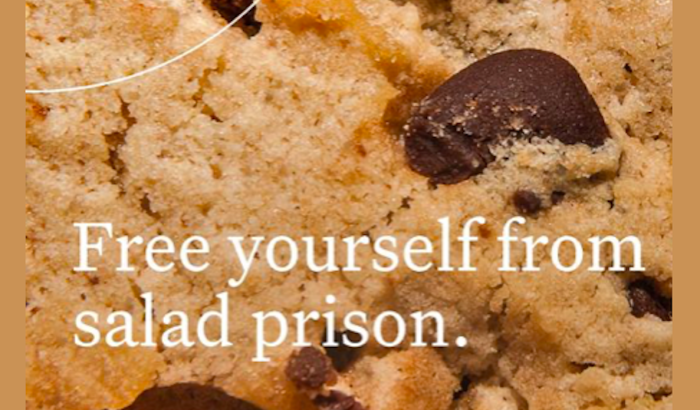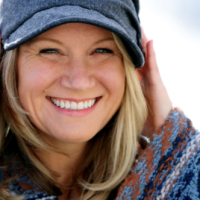This article is written in partnership with Noom—they’re dedicated to making healthy living easier for us all, and we’re honored to work with them. ~ ed.
As a whole, I love my body.
This sweet shell has enabled me to give birth four times, dance like nobody’s watching (and well when they were), hike mountains, and carry on about life without much of a thought—until an ankle or knee or a rash or something told me otherwise. Kinda like when I noticed a muffin top peeking over my corduroys a few weeks ago—and it was no longer just something to eye at the bakery.
I know how it happened. I’ve become a master at enjoying one mega meal and “healthy” snacking otherwise. But while sitting most of the day on the computer…oof. So not healthy.
Sure, I sit on a bouncy ball, stand, and have rubber stretch bands nearby, but I can do better—I know it. I want to rig my desk to my treadmill or bike.
I am done, like done-done, with screens at the end of my workday. But when I saw Noom Weight flash across my work screen a few weeks ago, I looked down and smiled at my jolly ol’ self and knew it was time for a li’l self-care.
Noom is a sustainable, mindfulness-based weight management app that focuses on the psychology behind getting bodies healthy—not the fads that almost guarantee long-term failure.
Start your journey to more healthful eating—that actually lasts— with Noom >>

“Do you believe?”
That’s what the app asked when I began the sign-up process, and it’s a core belief threading through the program. Awww, how sweet. Now, I am an outwardly positive person, but I heard my inner voice immediately answering snarkily:
Do I believe I can do this—lose the pounds? Totally, yeah.
Do I believe I need an app to help me? Ummm, not really. I just haven’t tried. Besides, online apps tracking anything have flopped for me in the past.
And then came the “real” question of the day:
Can I believe in a program that is going to help me with my first two answers?
My best attempts, vast knowledge, and thinking have gotten me right where I am—putting pressure on myself in a not-so-friendly way that gave me some extra padding for the winter.
So, I gave myself a dose of the self-compassion that I lend to others and pressed the “I believe” button. And ya know what? I got excited.
The red, yellow, and green flags of foods.
During my first few days, something became quite apparent: we don’t need to restrict what we are eating to lose weight. In fact, it’s detrimental to our goals and our health when we do.
We’re told lots of contradictory things when it comes to healthy eating: eat fruit, but avoid bananas because they have too much sugar. Carbs are good, but not before bed, etc. With all of these sequiturs, it can be hard to know what to do.
The route to better eating habits shouldn’t feel like a maze. In fact, they’re right this way >>
Laura Boukas, a Noom dietitian, has something to say about two of the biggest myths that actually hurt our weight loss goals—and a healthier, more personalized alternative we can all do instead:
“One of the biggest myths around eliminating food groups is that it will help you reach your goals more effectively,” Boukas says. “But oftentimes, if we eliminate food groups, it can create a very strong negative stigma around a particular food.”
From a psychological standpoint, this is called all-or-nothing thinking. And just like being black-and-white in other areas of life, it doesn’t work with dieting either. Here’s an example of why:

Don’t think of a pink elephant.
Chances are you just saw a pink elephant in your mind, right? That’s because that’s how our brains roll. As the saying goes: we all want what we can’t have.
Like anything else, “food can become more rewarding when it’s ‘off-limits,’” says Boukas. That’s something we all know too well. And it can make us especially susceptible to caving and setting off a psychological chain of motivational slips during times when we’re tired, stressed, or experiencing a change in routine.
That’s one reason that Noom separates our food choices into three categories: Green, Yellow, and Red, with a recommended guideline of eating 30 percent in the Green, 45 percent in the Yellow, and 25 percent in the Red.
So basically, just like in our relationships, we want to have as few red flags as possible, we can handle a couple of extra yellow ones here and there, and of course, we’d like unlimited green flags to be a-wavin’!
Here’s the main idea: you shouldn’t fully restrict yourself from eating anything when it comes to healthy eating. A few “red flags” of food are fine. (Yep, you read that correctly.) It’s just a matter of watching your red food meter skyrocket as your suggested calorie count plummets with every rumble of the tummy you chose to fill with your favorite, often nutrient-deficient, splurge foods.
Follow your heart (and tummy) to a healthier relationship with food >>
To my surprise, my diet seemed to be in a swing state between Green and Red. Protein shakes and “Keto” typed items were Red due to their high caloric density, meaning between the water, fat, and nutrient content in the foods, there was a higher likelihood that I’d end up hungry sooner than later due to the way most bodies tend to process food.
Who knew I was throwing myself outta whack while trying to stay on track? Noom did.
Sure, it’s easy to want to pound whatever magic elixir J.Lo endorses as her “secret weapon” for defying the rules of weight gain and aging. It’s even easier to want to try that hot, new diet we’ve been hearing about from our friend. But, as Boukas also says:
“In reality, different solutions work for different people, and it’s incredibly important to think about what works for you, your body, and your life.”
And when we watch how we feel and when we feel it after eating green, yellow, or red foods, we can come to gain a better understanding of what “does it” for our bodies, and what simply leaves us wanting for more and reaching for the lunch gutter.
“We’re all incredibly unique,” Bouka says. “Deciding what (and how much) of something makes you feel good is all about experimentation and listening to what your body needs.”
Less subtraction, more addition mindset.
You didn’t think we could stop at “no restricting,” right?
When we try to change behavior that is not ideal, we need to fill the void with a healthy replacement. In this case, as we slightly reduce the number of our personal problem foods, we want to focus on adding in new, healthier options.
Instead of thinking, “I have to eat less spaghetti” (oh man, what a bummer), we can shift our mindset to “I’m going to have a bigger salad tonight” (Mmmm, I get to eat more!).
How does this work, exactly? When we focus on the solution rather than the problem, our motivation to continue is higher, for starters. But also, as we fill our bellies with foods that have higher water and nutrient content, we’re likely to feel physically satisfied faster and eat fewer of those gut-fluffing foods that are dry, sticky, and lacking in nourishment for our bodies.

Tell me, do any of these “addition mindset” substitutes feel like super big bummers? Or do they sound like an interesting thing to try?
>> Sub spaghetti and beef meatballs for ground turkey meatballs, and replace half the spaghetti with zucchini noodles.
>> Add some veggies to your favorite pizza the next time you order.
>> Ask for extra veggies in your fried rice.
>> Add butternut squash or cauliflower to your mac & cheese, or if you’re an adventurous chef, make a cauliflower-based cheese sauce (if that doesn’t sound like a bit of culinary fun, I don’t know what does).
>> Toss a handful of spinach into any stew, soup, or smoothie.
>> Sub half of the oil in a baking recipe with applesauce.
>> Use avocado instead of mayo on sandwiches, or use half the mayo and double the mustard. (Ummm, you had me at avocado.)
When we aren’t in love with our bodies, it can be easy to want to punish ourselves until we make our way back to the shape we deem we’re supposed to be, only to have that work more toward our detriment than our success.
Psst! Self-love & mindful health goals are over here! >>
When we show ourselves and our bodies a bit of compassion and begin to take on (potentially delicious) new habits, we naturally move toward longer-lasting positive results.
I love my body—and that’s exactly why I’m looking forward to learning more about how to care for it.
I’m down a few pounds and up a whole heck of a lot in the belief department.
After all, as Noom says, “The difference between a try and a triumph is a little ‘umph,’” which is what the experience with the app has been so far.



Read 5 comments and reply